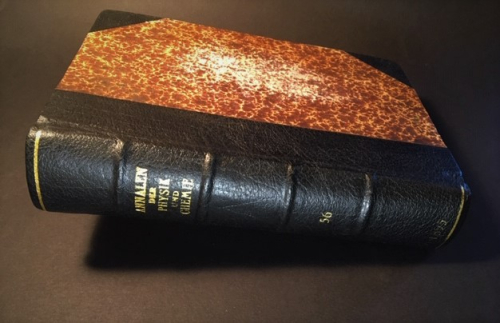EINTHOVEN, Willem. "Eine Isolationsvorrichtung gegen Erschutterungen der Umgebung", in Annalen der Physik und Chemie, 1895, vol 56, pp. 161- 166. Bound in period style leather and boards. Number on title page; otherwise beautiful, fine and clean $350.00
"In 1895, after the London physiologist A. D. Waller had published the curve for the action current of the heart as deduced from the body surface and had announced that he was unable to calculate its true shape (as recorded with Lippmann's capillary electometer), Einthoven repeated this experiment. He defined the physical constants of the capillary electrometer and calculated the true curve, which he called the electrocardiogram." - DSB.
“The first accurate recording of the electrocardiogram ...Einthoven, using an improved electrometer and a correction formula developed independently of Burch, distinguishes five deflections which he names P, Q, R, S and T.”--ECG Libvrary
“Einthoven derived a correction formula that compensated for the inertia and friction when using the mercury column of the Lippmann capillary electrometer....and...superimposed the mathematically corrected curve on the uncorrected curve. He had previously used ABCD to indicate the waves in the uncorrected tracing, and was forced to find other letters to label his corrected curve.”--Dr. Mike Cadogan, “History of the Electrocardiogram”.
Einthoven received the Nobel Prize in 1924 "for his discovery of the mechanism of the electrocardiogram." Nobel, the Man and his Prizes, pp. 262-265.
Wasson, Nobel Prize Winners, pp. 294-295




Comments